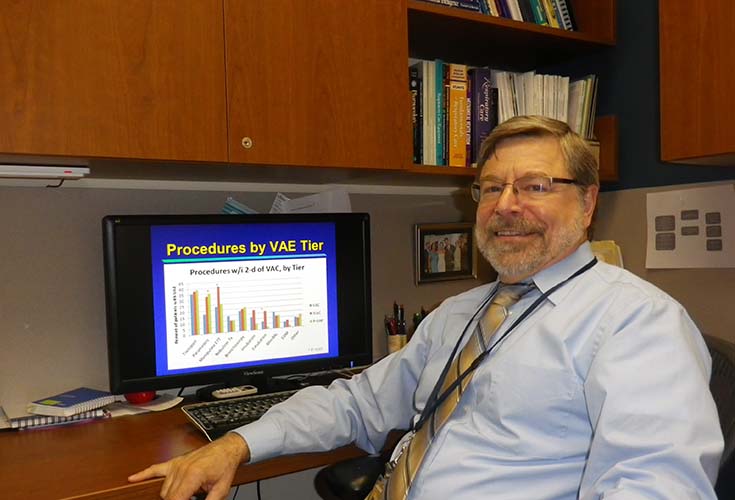 Carl Haas’ abstract on ventilator associated events is helping to clarify the role artificial airway manipulation may play in these adverse events.
Carl Haas’ abstract on ventilator associated events is helping to clarify the role artificial airway manipulation may play in these adverse events.
In this edition of the Open Forum Series, University of Michigan investigator Carl Haas, MLS, RRT-ACCS, CPFT, FAARC, explains why he got into clinical research, what it has meant to him to present his work during the AARC Congress, and how it felt to have his abstract, “Respiratory Procedures Done Prior to Onset of Ventilator Associated Events,” accepted for the Editors’ Choice session at the 2015 session in Tampa.
You are a seasoned researcher in respiratory care. What led to your interest in conducting research studies and how and when did you get started in the area?
My first project was in 1988. My medical director and mentor at the time, Dr. John G. Weg, was interested in patient transport, and we evaluated blood gas variability during our in-house transport of ventilated patients. Dr. Weg helped instill an inquisitive and scientific way of thinking in me.
How many Open Forum abstracts have you presented over the years and why do you continue to submit abstracts for consideration to this annual event in respiratory care?
I have 44 published abstracts, 33 of them in our journal Respiratory Care and presented at Open Forum. I love the comradery of those involved in this process.
When, where, and why did you decide to study respiratory procedures done prior to the onset of ventilator associated events (VAE)? What piqued your interest in this topic?
I am fortunate to co-chair our hospital VAE Taskforce with an infection preventionist. There is very little in the literature on preventing VAE, other than following the VAP bundle and using lung protective ventilator settings, and we were struggling with what to do next. A group of RT clinical specialists and I brainstormed ideas and hypothesized that manipulating the artificial airway might be related to VAE. We conducted a quality improvement project to count the number of various procedures that respiratory therapists frequently provide that involve fiddling with the ET tube, such as patient transport.
What were the biggest challenges you faced in carrying out this study and how did you overcome them?
One of the biggest challenges was the chart review. We went back and reviewed the medical records of over 250 patients with VAE. Getting many of the authors involved to help collect the data made it a much more manageable task.
How did it feel to learn that this abstract had been selected for the Editors’ Choice session at the Tampa Congress?
To be honest I had mixed feelings. I was extremely honored to have our project recognized in this way, but it also put pressure on us to write a manuscript in a short timeframe.
How do you think conducting studies and having them accepted to the Open Forum has helped to further your career in respiratory care?
Although there are many positive aspects, I think a main one has been the tremendous networking that occurs during these Open Forum sessions. Through these contacts, I feel comfortable reaching out to colleagues to ask clinical questions that I might have regarding clinical practice back home in our department. I think it also raises visibility, and you get invited to participate in projects that you might not otherwise be offered.
What advice do you have for other therapists who might like to follow in your footsteps but just don’t know how to get started?
I think a key is finding a good mentor to work with. Regarding topics to study, I tend to gravitate toward ongoing quality improvement efforts that I am involved with or questioning our current clinical practice.
What are you planning to study next?
I would like to continue on with VAE-related activities. We are currently reviewing our oxygenation management to determine whether it might be influencing the VAE rate.





